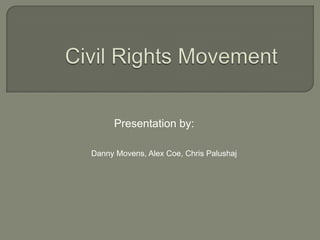
Civil Rights Movement Presentation Highlights Racial Segregation and Key Events
- 1. Civil Rights Movement Presentation by: Danny Movens, Alex Coe, Chris Palushaj
- 3. Segregation in Public Facilities Racial segregation is the separation of different racial groups in daily life. It applies to events such as eating in a restaurant, drinking from a water fountain, going to the movies, and attending school. Segregation is generally outlawed, but may exist. Segregation means action ranging from discrimination in hiring and in the rental and sale of housing to certain races to lynching.
- 4. Segregation White public treatment black public treatment
- 5. Civil Rights Act of 1964 The Civil Rights Act of 1964 prohibited discrimination in public facilities, in government, and in employment. Powers given to enforce the act were weak at first, but was building during later years. This was a great relief to the movement but, the movement fought for more rights to help their country become an equal economy, in the work place, schools, and convince the rest of the public that other races were important.
- 6. Separate but equal Separate but equal was a legal doctrine, but was not enforced with much effort. This was not completely enforced until later years.
- 7. Brown vs. The Board of Education
- 8. Brown vs. The Board Brown vs. The Board declared that there should be separate black and white schools. For much of the Brown case, race relations have been dominated by racial segregation. This policy had been endorsed by the U.S. Supreme court case of Plessy vs. Ferguson, which held that as long as the separate facilities for the separate races were "equal," segregation did not violate the Fourteenth Amendment ("no State shall... deny to any person... the equal protection of the laws.").
- 9. Brown vs. The Board Brown vs. The Board encouraged others to fight for the same rights. Brown boosted the civil rights movement, and showed people that they could be an impact as well, and if they did the same the movement would be a success.
- 10. Emmett Till Fourteen year old boy from Chicago, Emmett Till is visiting family in Mississippi when he is kidnapped, brutally beaten, shot, and dumped in the Tallahatchie River for whistling at a white woman. Two white men, J. W. Milam and Roy Bryant, are arrested for the murder and acquitted by an all-white jury. They later boast about committing the murder.
- 11. Spark of the movement The murder of Emmett Till baffled some across the country. This wanted all races to help, even whites. This was a big spark and got the movement going.
- 12. Non-violent organizations NAACP – National Association for the Advancement of Colored People. One of the oldest civil rights organizations. It’s mission, to ensure the political, educational, and economic equality rights. SNCC – Student Non-violent Coordinating Committee. An Organization supporting freedom walks, and sit-ins, being a leading role in the March on Washington.
- 13. March on Washington Large group of different races gathering for Dr. Martin Luther King’s famous speech.
- 14. Malcolm X Malcolm X respected Dr King. But, had a different opinion. He believed that using violence to assert their ways would work in the long run. He believed that if we wait around and hope, nothing is going to come out of it. We need to take action, Malcolm thought. He wanted whites to respect them but, he still wanted to be separated.
- 15. Black Panther Party forms after Malcolm X’s speech The Black Panther Party didn’t wait for rights to come to them, they fought until whites respected them, but they still wanted to be separated.
- 16. Thanks for watching!
